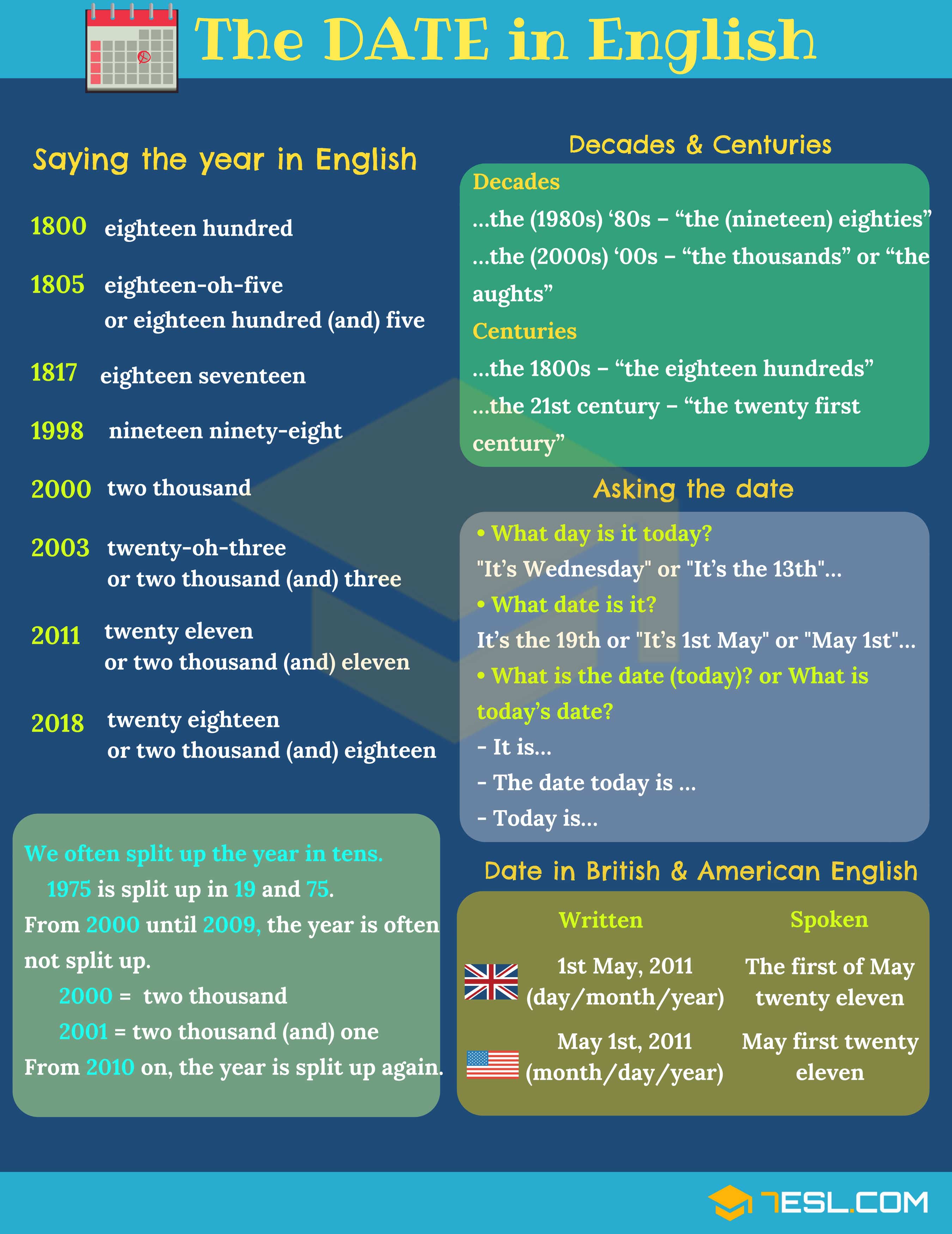How to Say and Write the DATE Correctly in English
İngilizce TARİHLER Nasıl Doğru Söylenir ve Yazılır

How to say and write the date in American and British English correctly through pictures and examples. Learn these common phrases to improve your English.
Resim ve örneklerle Amerikan ve İngiliz İngilizcesinde tarih nasıl doğru söylenir ve yazılır. İngilizcenizi geliştirmek için bu yaygın ifadeleri öğrenin.
The Date in English
İngilizcede Tarih
General Genel
Saying the Year in English İngilizcede Yılları Söylemek
1800: eighteen hundred
1805: eighteen hundred (and) five
Or eighteen oh-five
1817: eighteen seventeen
1998: nineteen ninety-eight
2000: two thousand
2003: two thousand (and) three
Or twenty oh-three
2011: two thousand (and) eleven
Or twenty eleven
2018: two thousand (and) eighteen
Or twenty eighteen
We often split up the year in tens. Yılı genellikle onluklara böleriz.
1975 is split up in 19 and 75. (You say: nineteen seventy-five).
1975 19 ve 75'e bölünmüştür. (You say: nineteen seventy-five: Doksan yetmiş beş diyorsunuz).
From 2000 until 2009 the year is normally not split up.
2000'den 2009'a kadar yıl normalde bölünmez.
- 2000: two thousand
- 2001 = two thousand (and) one
The word and is often left out. From 2010 on the year is split up again.
"and" kelimesi genellikle dışarıda bırakılır. 2010 yılından itibaren yıl tekrar bölünür.
2010 is split up in 20 and 10. (You say: twenty ten).
2010 20 ve 10'a bölünmüştür. (You say: twenty ten) (Yirmi on diyorsunuz).
BC – Before Christ İsa'dan / Milattan Önce
AD – Anno Domini Milattan Sonra
Decades On yıllar
…the (1980s) ‘80s – “the (nineteen) eighties”
…the (2000s) ‘00s – “the thousands” or “the aughts”.
Centuries Yüz Yıllar
…the 1800s – “the eighteen hundreds”
…the 6th century – “the sixth century”
…the 21st century – “the twenty first century”
Ordinal Numbers Sıra Sayıları
- 1st – first birinci
- 2nd – second İkinci
- 3rd – third üçüncü
- 4th – fourth dördüncü
- 5th – fifth beşinci
- 6th – sixth altıncı
- 7th – seventh yedinci
- 8th – eighth sekizinci
- 9th – ninth dokuzuncu
- 10th – tenth onuncu
- 11th – eleventh on birinci
- 12th – twelfth on ikinci
- 13th – thirteenth on üçüncü
- …
- 20th – twentieth yirminci
- 21st – twenty-first yirmi birinci
- 22nd – twenty-second yirmi ikinci
- 23rd – twenty-third yirmi üçüncü
- …
- 30th – thirtieth otuzuncu
- 31st – thirty-first otuz birinci
- 40th – fortieth kırkıncı
- 41st –forty-first kırk birinci
- 50th – fiftieth ellinci
- 51st – fifty-first elli birinci
Saying and Writing the Date in English
İngilizce Tarihleri Söyleme ve Yazma
We often use ordinal numbers for the date in spoken English.
Konuşulan İngilizcede tarih için genellikle sıra sayıları kullanırız.
Asking the Date Tarih Sorma
- What day is it today? Bugün günlerden ne?
“It’s Wednesday” or “It’s the 13th”… - What date is it? Bu gün tarih?
“It’s the 19th” or It’s “19th May” or “May 19th”…
- What is the date (today)?or What is today’s date?
Tarih nedir (bugün) veya bugünün tarihi nedir?
- It is…
- The date today is … Bu gün tarih ....
- Today is… Bu gün ...
How to use IN, ON with Year, Month, Date…
Yıl, Ay, Tarih ... ile IN, ON nasıl kullanılır…
In + Years In + Yıllar
in 1980, in 1968, in 1995, in 1963, in 2018…
Examples: Örnekler
- He was born in 1980. 1980 yılında doğdu.
- I lived there in 1995. 1995 yılında orada yaşadım.
In + Months In + Aylar
in January, in February, in December…
Examples:
- He joined the Army in February 1943. Şubat 1943'te orduya katıldı.
- His latest book will appear in December. Son kitabı Aralık ayında çıkacak.
In + Decades In + On Yıllar
in the 1960s, in the seventies, in the 1990s…
Examples:
- It was built as a new town in the 1960s.
1960'larda yeni bir kasaba olarak inşa edilmiştir.
- She became a household name in the 1960s.
1960'larda bir hane adı oldu.
In + Centuries In + Yüz Yıllar
in the 15th century, in the 18th century, in the 21st century…
Examples:
- It was built in the 18th century. 18. yüzyılda inşa edilmiştir.
- Micro-mechanism is one of the key technologies in the 21th century.
Mikro mekanizma, 21. yüzyılın en önemli teknolojilerinden biridir.
On + Dates On + Tarihler
on April 3rd, on 1st January 2013, on the 10th, on the first day, on the last day…
Examples:
- The formal signing will take place on April 9th. Resmi imza 9 Nisan'da yapılacak.
- We will celebrate on October 1st. 1 Ekim'de kutlayacağız.
On + Days On + Günler
on Monday, on Thursday, on Sunday…
Examples:
- He wasn’t there on Monday; nor on Tuesday, for that matter.
Bu konu için ne Pazartesi günü ne de Salı günü oradaydı
- Shall we go to the theatre on Friday? Cuma günü tiyatroya gidelim mi?
Writing and Saying the Date in British English
İngiliz İngilizcesinde Tarihi Yazma ve Söyleme
Rule: Day – Month – Year Kural : Gün - Ay - Yıl
Writing (Yazılış): 1st February, 2011
Saying (Söyleniş): The first of February twenty eleven
Writing and Saying the Date in American English
Amerikan İngilizcesinde Tarih Yazma ve Söyleme
Rule: Month – Day – Year Kural: Ay - Gün - Yıl
Writing (Yazılış):: February 1st, 2011
Saying (Söyleniş): February first twenty eleven
KAYNAK : https://7esl.com/the-date/



